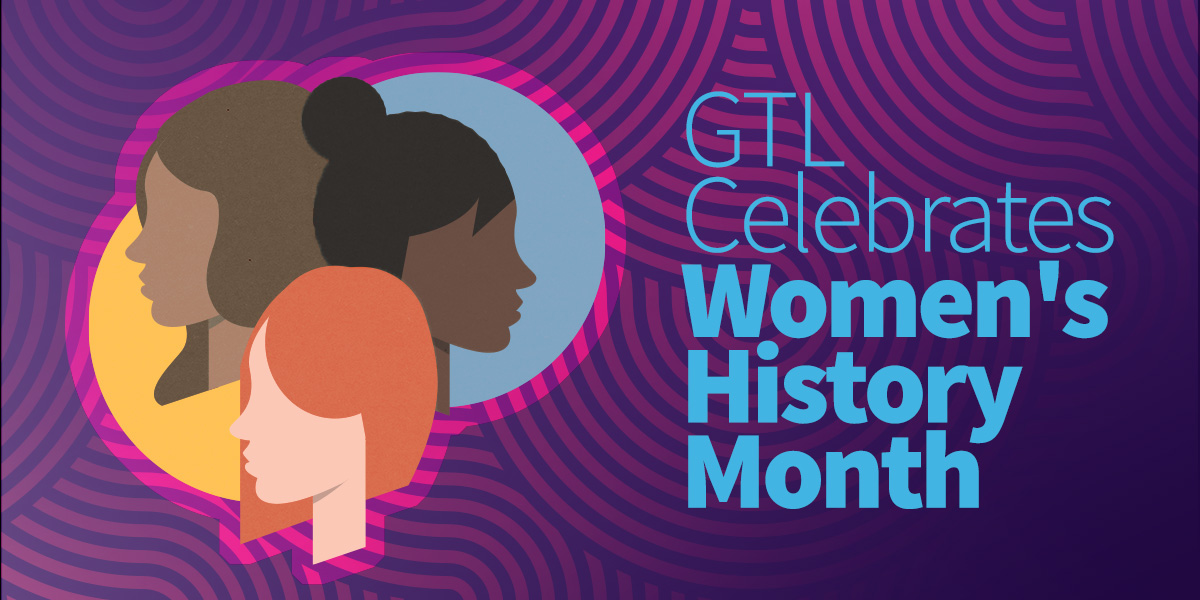GTL Celebrates Women’s History Month
March 16, 2021
In March, the immeasurable impact women have made on society is commemorated. From ladies who live out their dream job every day to admired celebrities to changemakers throughout the world, Women’s History Month gives us a chance to celebrate all women, especially the women at GTL!
It all began with a single March day in 1908 when thousands of women united and marched for better labor laws, working conditions, and the right to vote. Then in March of 1972, Title IX was passed, which protects from gender discrimination. In 1975, the United Nations officially began sponsoring International Women’s Day on March 8. In 1987, Congress declared March as Women’s History Month in perpetuity.
As we celebrate Women’s History Month, we are honoring all women at GTL who bring their authentic self to work every day. Women play a vital role at GTL: leading, inspiring, innovating, collaborating, and setting the stage for future growth. Throughout the month, we will highlight women that have changed the world and share inspiring stories of our own employees.
GTL is a company that celebrates the accomplishments and contributions of women, both past and present, not only in March but throughout the entire year. We always have time to learn more and to promote equality and equity for all.
Watch a message from our President & CEO, Deb Alderson, about the importance of Women’s History Month.

Dr. Virginia Apgar – Obstetrical Anesthesiology and Medical Researcher
Dr. Virginia Apgar was an American physician, obstetrical anesthesiologist, and medical researcher. She is best known as the inventor of the Apgar Score, which quickly assesses the health of a newborn baby. The test is usually given twice: once at 1 minute after birth and again at 5 minutes after birth. Five points—heart rate, respiratory effort, muscle tone, reflex response, and color—are observed and given 0–2 points, which are then totaled to arrive at the baby’s score. The higher the score, the better the newborn is doing.
Dr. Apgar was a leader in the fields of anesthesiology and teratology (the scientific study of congenital abnormalities and abnormal formations). She graduated from Mount Holyoke College in 1929 and from the Columbia University College of Physicians and Surgeons in 1933. In 1937, she became the first female board-certified anesthesiologist, and in 1949, she became the first woman full professor at the Columbia University College of Physicians and Surgeons. Dr. Apgar headed the division of congenital malformations at the National Foundation for Infantile Paralysis (now known as the March of Dimes) from 1959–1967. She cowrote the book Is My Baby All Right? in 1972 and passed away on August 7, 1974.
 Bertha Parker Pallan Cody – First Native American Female Archaeologist
Bertha Parker Pallan Cody – First Native American Female Archaeologist
Born in 1907, Bertha Parker Pallan Cody is considered one of the first female Native American archaeologists. She was of Abenaki and Seneca descent, born in Chautauqua County, New York, to an actress mother and an archaeologist father. As a child, she assisted her father in his excavations.
After her first marriage ended, Bertha relocated to Nevada and began work on an archaeological site as a camp cook and expedition secretary. She helped to excavate Mesa House and other locales, learning archaeological methods from her uncle-in-law Mark Raymond Harrington. In 1930, she began work at Gypsum Cave, which was believed to have the earliest evidence of human occupation of North America during the Ice Age.
Bertha cleaned, repaired, and catalogued finds during the expedition. In her spare time, she explored Gypsum Cave and discovered the skull of a species of extinct giant ground sloth, which brought a spotlight to the expedition and drew the support of institutions such as the California Institute of Technology and Carnegie Institution of Washington. She also discovered the site of Corn Creek after discovering a fossil camel bone protruding from an eroding lakebed.
Following the Gypsum Cave expedition, she worked as an Assistant in Archaeology and Ethology at the Southwest Museum for ten years. During this time, and for years after, Bertha published many archaeological and ethnological papers in the museum journal, Masterkey. In her later years, Bertha worked as a technical advisor and consultant on TV shows and movies depicting Native Americans. She also hosted a TV show on Native American history and folklore in the 1950s with her third husband, Iron Eyes Cody.
Without a university education, Bertha was able to conduct archaeological work at a high level of skill, making many discoveries and contributing to the further understanding of human history. She died in 1978.
 Grace Brewster Murray Hopper – Computer Scientist and Navy Rear Admiral
Grace Brewster Murray Hopper – Computer Scientist and Navy Rear Admiral
Born in 1906, Grace Brewster Murray Hopper was an American computer scientist and a Rear Admiral in the United States Navy. She earned a bachelor’s degree in mathematics and physics from Vassar College and a master’s and Ph.D. in mathematics from Yale. After the bombing of Pearl Harbor, Hopper joined the U.S. Naval Reserve (Women’s Reserve), beginning an assignment at the Bureau of Ships Computation Project at Harvard University.
At Harvard, Hopper worked under Howard Aiken and was responsible for programming and writing the 561-page user manual for the IBM Automatic Sequence Controlled Calculator, better known as the Mark I, one of the earliest electromechanical computers. After the war, Hopper helped develop the Mark II and Mark III computers and coined the computer terms “bug” and “debugging” when a moth made its way into the Mark II.
After leaving Harvard, Hopper went on to work on the UNIVAC I (Universal Automatic Computer) and advocated for the use of COBOL (common business-oriented language) as the first standardized general business computer language. Forced to retire from the Navy in 1966 due to her age, Hopper was recalled to active duty just seven months later to standardize the Navy’s multiple computer languages. She remained on active duty for 19 years.
Hopper retired as a rear admiral at the age of 79, making her the oldest serving officer in the U.S. Armed Forces at the time. Never one to be still, she went to work as a senior consultant in public relations, which she did until a year before her death in 1992. She was buried with fully military honors in Arlington National Cemetery and posthumously received the Presidential Medal of Freedom in 2016.
Recognizing the Women of GTL
As Women’s History Month comes to an end, there is a group of women that must be recognized – The Women of GTL.
GTL’s workforce is comprised of amazing women who spend their days assisting facility clients, working with friends and family customers, and furthering the technology that allows us to transform the incarceration experience. Led by our amazing CEO, Deb Alderson, the women of GTL deserve recognition during this month’s celebration of women!
Thank you to each and every one of you who lead by example and contribute to the furthering of this company!

Reach out to your loved one and extend your support!
Posted In: Blog




